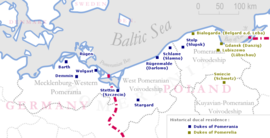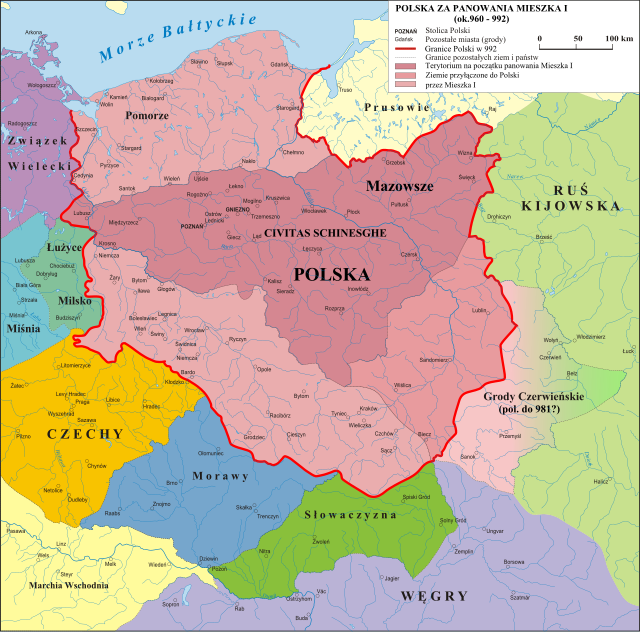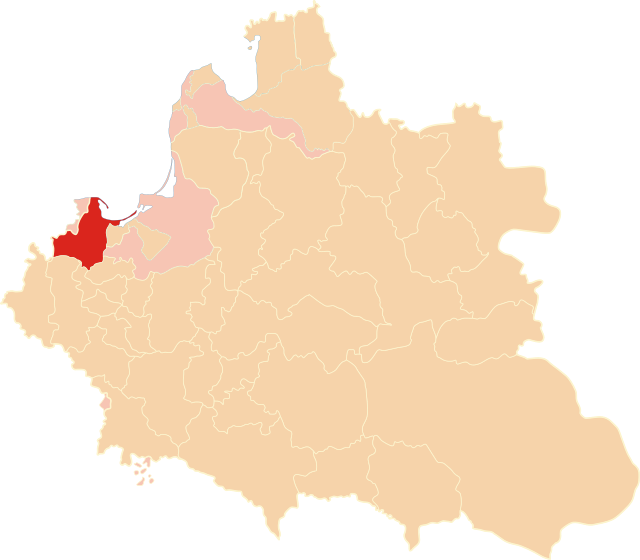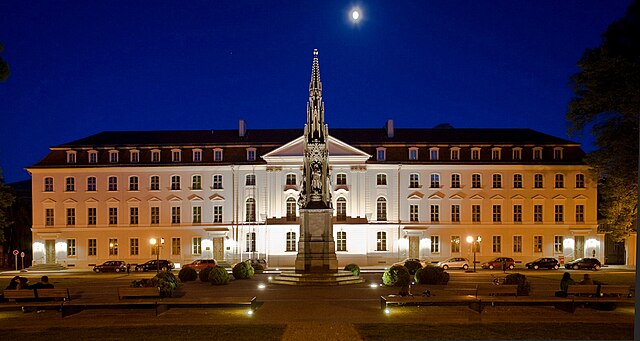Pomerania
Historical region on the southern shore of the Baltic Sea in Central Europe From Wikipedia, the free encyclopedia
Historical region on the southern shore of the Baltic Sea in Central Europe From Wikipedia, the free encyclopedia
Pomerania (Polish: Pomorze [pɔˈmɔʐɛ] ⓘ; German: Pommern [ˈpɔmɐn] ⓘ; Kashubian: Pòmòrskô; Swedish: Pommern) is a historical region on the southern shore of the Baltic Sea in Central Europe, split between Poland and Germany. The central and eastern part belongs to the West Pomeranian, Pomeranian and Kuyavian-Pomeranian voivodeships of Poland, while the western part belongs to the German states of Mecklenburg-Western Pomerania and Brandenburg.
Pomerania
| |
|---|---|
Historical region | |
| |
 Contemporary administrative units with Pomerania in the name, not representing the exact historical region, as they also include parts of other regions | |
| Coordinates: 54.29°N 18.15°E | |
| Countries | Poland Germany |
| Largest cities | in Poland: Gdańsk, Szczecin in Germany: Greifswald, Stralsund |
| Demonym | Pomeranian |
| Time zone | UTC+1 (CET) |
| • Summer (DST) | UTC+2 (CEST) |
| Primary airports | Gdańsk Lech Wałęsa Airport Solidarity Szczecin–Goleniów Airport |
| Highways | |
Pomerania's historical border in the west is the Mecklenburg-Western Pomeranian border Urstromtal,[a] which now constitutes the border between the Mecklenburgian and Pomeranian part of Mecklenburg-Western Pomerania, while it is bounded by the Vistula River in the east. The easternmost part of Pomerania is alternatively known as Pomerelia, consisting of four sub-regions: Kashubia inhabited by ethnic Kashubians, Kociewie, Tuchola Forest and Chełmno Land.
Pomerania has a relatively low population density, with its largest cities being Gdańsk and Szczecin. Outside its urban areas, it is characterized by farmland, dotted with numerous lakes, forests, and small towns. In the west of Pomerania lie several islands, the largest of which are Rügen, the largest island in Germany; Usedom/Uznam, and Wolin, the largest island in Poland. The region has a rich and complicated political and demographic history at the intersection of several cultures.

Pomerania is the area along the Bay of Pomerania of the Baltic Sea between the rivers Recknitz, Trebel, Tollense and Augraben in the west and Vistula in the east.[1][2] It formerly reached perhaps as far south as the Noteć river, but since the 13th century its southern boundary has been placed further north.
Most of the region is coastal lowland, being part of the Central European Plain. Its southern, hilly parts belong to the Baltic Ridge, a belt of terminal moraines formed during the Pleistocene. Within this ridge, a chain of moraine-dammed lakes constitutes the Pomeranian Lake District. The soil is generally rather poor, sometimes sandy or marshy.[1]
The western coastline is jagged, with many peninsulas (such as Darß–Zingst) and islands (including Rügen, Usedom, and Wolin) enclosing numerous bays (Bodden) and lagoons (the biggest being the Lagoon of Szczecin).
The eastern coastline is smooth. Łebsko and several other lakes were formerly bays, but have been cut off from the sea. The easternmost coastline along the Gdańsk Bay (with the Bay of Puck) and Vistula Lagoon, has the Hel Peninsula and the Vistula peninsula jutting out into the Baltic.
The Pomeranian region has the following administrative divisions:
The bulk of Farther Pomerania is included within the modern West Pomeranian Voivodeship, but its easternmost parts (the Słupsk area) now constitute the northwest of Pomeranian Voivodeship. Farther Pomerania in turn comprises several other historical subregions, most notably the former Principality of Cammin, the Nowogard County, and the Słupsk and Sławno Land. The Lębork and Bytów Land is considered a part of Pomerelia (Kashubia) by the Polish historiography, and of Farther Pomerania by the German historiography.
Parts of Pomerania and surrounding regions have constituted a euroregion since 1995. The Pomerania euroregion comprises Hither Pomerania and Uckermark in Germany, West Pomerania in Poland, and Scania in Sweden.
In Lechitic languages the prefix "po-" means along; unlike the word "po", which means after. Pomorze, therefore, means Along the Sea. This construction is similar to toponyms Pogórze (Along the Mountains), Polesie (Along the Forest), Porzecze (Along the River), etc.
Pomerania was first mentioned in an imperial document of 1046, referring to a Zemuzil dux Bomeranorum (Zemuzil, Duke of the Pomeranians).[3] Pomerania is mentioned repeatedly in the chronicles of Adam of Bremen (c. 1070) and Gallus Anonymous (ca. 1113).
The territorial designation "Pomerania" lacks a universally accepted definition, since it may refer either to combined Hither and Farther Pomerania only (in German contemporary and historical usage[4]) or to Hither and Farther Pomerania combined with Pomerelia (in Polish contemporary and historical usage).
As a consequence, the term "West Pomerania" is ambiguous, since it may refer to either Hither Pomerania (in German usage and historical usage based on German terminology[4]), or to combined Hither and Farther Pomerania (in Polish usage and historical usage based on German terminology). In parallel, the term "East Pomerania" may similarly carry different meanings, referring either to Farther Pomerania (in German usage and historical usage based on German terminology[4]), or to Pomerelia (in Polish usage and historical usage based on German terminology).
As a further complication, the borders of the eponymous administrative units have been drawn disregarding mostly the historical ones. The Polish unit called województwo zachodniopomorskie (West Pomeranian Voivodeship) includes the whole Polish part of Hither Pomerania, but only the western two-thirds of Farther Pomerania, with the remaining easternmost one-third (Słupsk, Ustka, and Miastko) has been part of the województwo pomorskie ([East-]Pomeranian Voivodeship). The former regional unit stretches however far more south than the historical region, to include the northern part of the historical Neumark (Dębno, Chojna, Trzcińsko-Zdrój, Myślibórz, Nowogródek Pomorski, Lipiany, Barlinek, Pełczyce, Suchań, Choszczno, Recz, and Drawno), as well as a strip the historical Greater Poland (Tuczno, Człopa, Mirosławiec, Wałcz, and Czaplinek), or even a small part of Pomerelia (Biały Bór); in turn the other one comprises only approximately northern two-thirds of Pomerelia but also parts of historical Malbork Land and Upper Prussia known under the ethnographic designation of Powiśle and constituting the westernmost strip of historical Prussia; and finally, the remaining one third of Pomerelia forms part of województwo kujawsko-pomorskie (Kuyavian-Pomeranian Voivodeship), a further regional unit, in this case bearing a name accurately reflecting historical heterogeneity of its territory. Similarity but to lesser extent, borders of the combined German districts Vorpommern-Rügen and Vorpommern-Greifswald deviate significantly in numerous locations from the historical ones with Mecklenburg and Brandenburg. As a consequence, the common understanding of the terms has started to be used more and more frequently in the sense of the current administrative units.
| West | Pomerania | East | Southeast | ||||||||||||||||||
| Ahrenshoop (westernmost Pomeranian settlement), Ribnitz-Damgarten (Damgarten only), Saal, Prerow, Zingst, Barth, Tribsees, Franzburg, Richtenberg, Grimmen, Stralsund, DÄNHOLM |
Rügen HIDDENSEE, UMMANZ, Garz/Rügen, Bergen auf Rügen, Putgarten, VILM, Sagard, Binz, Sassnitz, Sellin, Thiessow, Göhren |
Loitz, Gützkow, Greifswald, Lubmin, Kröslin, RUDEN, GREIFSWALDER OIE, Wolgast, Lassan |
Kummerow, Sommersdorf, Verchen, Demmin, Altentreptow |
Alt Tellin, Jarmen, Anklam |
Usedom Peenemünde, Karlshagen, Trassenheide, Zinnowitz, GÖRMITZ, Usedom, Zempin, Koserow, Loddin, Ückeritz, Bansin, Heringsdorf, Ahlbeck |
Pasewalk, Torgelow, Ueckermünde, Eggesin, Löcknitz, Penkun, Altwarp, Pomellen (easternmost settlement in M.-V.) |
Schwedt/Oder (districts north of the Welse river only), Gartz (Oder), Mescherin (easternmost Pomeranian settlement in Germany) |
Uznam/Wolin Świnoujście, Międzyzdroje, Wolin, Międzywodzie, CHRZĄSZCZEWSKA, Dziwnów (left-bank) |
Goleniów, Police, Nowe Warpno, Szczecin, Dąbie |
Widuchowa, Gryfino, Banie, Pyrzyce |
Maszewo, Stargard, Stepnica, Dziwnów (right-bank with historic centre), Kamień Pomorski, Golczewo, Ińsko, Dobrzany, Dolice, Chociwel, Gryfice, Gościno, Płoty, Nowogard, Łobez, Węgorzyno, Resko, Trzebiatów |
Świdwin, Połczyn-Zdrój, Kalisz Pomorski, Drawsko Pomorskie, Złocieniec, Kołobrzeg, Koszalin, Polanów, Sianów, Karlino, Tychowo, Bobolice, Białogard, Biały Bór, Szczecinek, Sławno, Darłowo |
Ustka, Słupsk, Miastko |
Łeba, Lębork, Bytów (Lauenburg and Bütow Land German: Lande Lauenburg und Bütow Polish: Ziemia lęborsko-bytowska) |
Człuchów, Chojnice, Kościerzyna, Kartuzy, Żukowo, Puck, Władysławowo, Jastarnia, Hel |
Wejherowo, Reda, Rumia, (so-called Little Kashubian Tricity) Gdynia, Sopot, Gdańsk (Tricity) Pruszcz Gdański, Nowy Staw, Krynica Morska |
Starogard Gdański, Skarszewy, Pelplin, Tczew, Gniew |
Świecie, Nowe |
Tuchola, Pruszcz |
Toruń, Grudziądz, Chełmno, Chełmża, Wąbrzeźno, Kowalewo Pomorskie, Jabłonowo Pomorskie, Radzyń Chełmiński, Łasin, Brodnica (part north of Drwęca with historic center), Golub | |
| Current countries | Germany | Poland | |||||||||||||||||||
| Current administrative regions | Mecklenburg-Vorpommern (Mecklenburg-Western Pomerania) |
Brandenburg | województwo zachodniopomorskie (West Pomeranian Voivodeship) |
województwo pomorskie (Pomeranian Voivodeship) |
województwo kujawsko-pomorskie (Kuyavian-Pomeranian Voivodeship) | ||||||||||||||||
| Vorpommern-Rügen | Vorpommern-Greifswald | Mecklenburgische Seenplatte | Vorpommern-Greifswald | Uckermark | |||||||||||||||||
| German terminology (corresponding English term) |
Pommern[1] (Pomerania) bounded in the west by the Recknitz, Trebel and Lake Kummerow, and in the east by the Piaśnica |
Pomerellen, Pommerellen[1] (Pomerelia)[1] After Partitions of Poland, part of the wider Westpreussen (West Prussia) before Partitions of Poland, part of the wider Königlich-Preußen or Preußen Königlichen Anteils (Royal Prussia) | |||||||||||||||||||
| Vorpommern (Hither Pomerania, Fore Pomerania) in modern usage the part located in Germany only |
Hinterpommern (Farther/Further Pomerania, Rear Pomerania) |
Kaschubei[5] (Kashubia) areas south-east of Könitz (Schwarzwasser, Czersk): Tucheler Heide (Tuchola Forest), Koschneiderei |
Kociewie | Tucheler Heide (Tuchola Forest), Koschneiderei |
Kulmerland (Chełmno Land) | ||||||||||||||||
| Neuvorpommern (New Hither Pomerania) western part of Swedish Pomerania that went from Sweden to Prussia in 1815 |
Altvorpommern (Old Hither Pomerania) eastern part of Swedish Pomerania that went from Sweden to Prussia in 1720 | ||||||||||||||||||||
| Westpommern (Western Pomerania) mainland west of the Zarow and Rügen archipelago |
Mittelpommern (Middle Pomerania) mainland east of the Zarow as well as Usedom and Wolin |
Ostpommern (Eastern Pomerania) | |||||||||||||||||||
| Mittelpommerscher Keil (Middle Pomeranian Wedge) excluding Uznam and Wolin |
|||||||||||||||||||||
| Polish terminology (corresponding English term) |
Pomorze Zachodnie (Western Pomerania) Pomorze Nadodrzańskie (Oder Pomerania) |
Pomorze Wschodnie (Eastern Pomerania) Pomorze Nadwiślańskie (Vistula Pomerania) before World War II simply Pomorze[1] (Pomerelia,[1] literally Pomerania) before Partitions of Poland, part of the wider Prusy Królewskie (Royal Prussia) | |||||||||||||||||||
| Pomorze Zaodrzańskie (Trans-Oder Pomerania) Pomorze Wołogoskie (Wołogoszcz or German: Wolgast Pomerania) |
Pomorze Szczecińskie (Szczecin Pomerania) Pomorze Zachodnie w węższym znaczeniu (Western Pomerania in narrower sense) |
Pomorze Środkowe (Middle Pomerania) Pomorze Koszalińsko-Słupskie (Koszalin and Słupsk Pomerania) |
Pomorze Gdańskie (Gdańsk Pomerania) |
Ziemia chełmińska (Chełmno Land) ethnocultural region | |||||||||||||||||
| Pomorze Przednie (Hither Pomerania, Fore Pomerania) in modern usage the part located in Germany only |
Pomorze Tylne (Farther/Further Pomerania, Rear Pomerania) usage limited mainly to translations of German texts |
Kaszuby (Kashubia) ethnocultural region areas south-east of Chojnice (Czarna Woda, Czersk): Bory Tucholskie (Tuchola Forest) ethnocultural region, Kosznajderia former ethnocultural region |
Kociewie ethnocultural region |
Bory Tucholskie (Tuchola Forest) ethnocultural region, Kosznajderia former ethnocultural region | |||||||||||||||||
| Kashubian terminology (corresponding English term) |
Zôpadnô Pòmòrskô (Western Pomerania) |
Lãbòrskò-bëtowskô Zemia (Lębork and Bytów Land) |
Pòrénkòwô Pòmòrskô (Eastern Pomerania) | ||||||||||||||||||
| Kaszëbë (Kashubia ethnocultural region) |
Kòcéwskô (Kociewie) ethnocultural region |
Tëchòlsczé Bòrë (Tuchola Forest) ethnocultural region, Kòsznajderiô (Kosznajderia) former ethnocultural region |
Chełmińskô Zemia (Chełmno Land) ethnocultural region | ||||||||||||||||||

Settlement in the area called Pomerania for the last 1,000 years started by the end of the Vistula Glacial Stage, some 13,000 years ago.[6] Archeological traces have been found of various cultures during the Stone and Bronze Age, Baltic peoples, Germanic peoples and Veneti during the Iron Age and, in the Dark Ages, West Slavic tribes and Vikings.[7][8][9][6][10][11][12] Starting in the 10th century, early Polish rulers subdued the region, successfully integrating the eastern part with Poland, while the western part fell under the suzerainty of Denmark and the Holy Roman Empire in the late 12th century.[13][14][15][16][17][18][19] Gdańsk, established during the reign of Mieszko I of Poland has since become Poland's main port (apart from periods of Poland losing control over the region).
In the 12th century, the Duchy of Pomerania (western part), as a vassal state of Poland, became Christian under saint Otto of Bamberg (the Apostle of the Pomeranians); at the same time Pomerelia (eastern part) became a part of diocese of Włocławek within Poland. Since the late 12th-early 13th century, the Griffin Duchy of Pomerania stayed with the Holy Roman Empire and the Principality of Rugia with Denmark, while Pomerelia, under the ruling of Samborides, was a part of Poland.[20][21][22][23] Pomerania, during its alliance in the Holy Roman Empire, shared borders with West Slavic state Oldenburg, as well as Poland and the expanding Margraviate of Brandenburg. In the early 14th century the Teutonic Knights invaded and annexed Pomerelia from Poland into their monastic state, which already included historical Prussia. As a result of the Teutonic rule, in German terminology the name of Prussia was also extended to conquered Polish lands like Gdańsk Pomerania, although it was not inhabited by Baltic Prussians but Lechitic Poles. Meanwhile, the Ostsiedlung started to turn Slavic narrow Pomerania into an increasingly German-settled area; the remaining Wends and Polish people, often known as Kashubians, continued to settle within Pomerelia.[24][25] In 1325 the line of the princes of Rügen died out, and the principality was inherited by the Griffins.[26]

In 1466, with the Teutonic Order's defeat in the Thirteen Years' War, Pomerelia became again part of the Polish Crown and formed the Pomeranian Voivodeship within the provinces of Royal Prussia and Greater Poland.[27] While the German population in the Duchy of Pomerania adopted the Protestant reformation in 1534,[28][29][30] the Polish (along with Kashubian) population remained with the Roman Catholic Church. The Thirty Years' War severely ravaged and depopulated narrow Pomerania; few years later this same happened to Pomerelia (the Deluge).[31] With the extinction of the Griffin house during the same period, the Duchy of Pomerania was divided between the Swedish Empire and Brandenburg-Prussia in 1648, while Pomerelia remained in with the Polish Crown.



Prussia gained the southern parts of Swedish Pomerania in 1720,[32]: 341–343 invaded and annexed Pomerelia from Poland in 1772 and 1793, and gained the remainder of Swedish Pomerania in 1815, after the Napoleonic Wars.[32]: 363, 364 The former Brandenburg-Prussian Pomerania and the former Swedish parts were reorganized into the Prussian Province of Pomerania,[32]: 366 while Pomerelia was made part of the Province of West Prussia. With Prussia, both provinces joined the newly constituted German Empire in 1871. Under German rule, the Polish minority suffered discrimination and oppressive measures aimed at eradicating its culture.
Following the German Empire's defeat in World War I, however, eastern Pomerania/Pomerelia was returned to the rebuilt Polish state, while German-majority Gdańsk/Danzig was transformed into the independent Free City of Danzig. In the interbellum, the border with Poland and the creation of what German propaganda called the "Polish Corridor" were often contested in Germany. Irredentist claims towards Poland were one of the factors contributing to the rise of the Nazi Party in Germany. In 1938 Germany's Province of Pomerania was expanded to include northern parts of the former Province of Posen–West Prussia (part of historic Greater Poland).
Under the Nazi government, the persecution of Poles in the German-controlled part of Pomerania intensified. In January 1939, Germany resumed expulsions of Poles and many were also forced to flee.[33] The Sturmabteilung, Schutzstaffel, Hitler Youth and Bund Deutscher Osten launched attacks on Polish institutions, schools and activists.[34] From May to August 1939, the Gestapo carried out arrests of Polish leaders, activists, entrepreneurs, and even some staff of the Consulate of Poland in Szczecin.[35]

In September 1939, Germany invaded Poland starting World War II. The first battle of the war, at Westerplatte, was fought in the region. Afterwards the Polish part of Pomerania was annexed by Germany, and made part of the Reichsgau Danzig-West Prussia. The Nazis deported the Pomeranian Jews to a reservation near Lublin.[36] The Polish population suffered heavily during the Nazi oppression; more than 40,000 died in executions, death camps, prisons and forced labour, primarily those who were teachers, businessmen, priests, politicians, former army officers, and civil servants.[37] Thousands of Poles and Kashubians suffered expulsion, their homes taken over by the German military and civil servants, as well as some Baltic Germans resettled there between 1940 and 1943 in accordance with the Lebensraum policy. The Stutthof concentration camp with numerous subcamps was located in the region. There were also numerous Nazi prisons, forced labour camps, and multiple prisoner-of-war camps, including the large Stalag II-B and Stalag II-D, for Polish, French, Belgian, Dutch, Serbian, Italian, American, Canadian, Australian, New Zealander and other Allied POWs. Połczyn-Zdrój was the location of a Germanisation camp for kidnapped Polish children.[38] The Polish resistance movement was active both in the pre-war Polish part and the pre-war German part of Pomerania.
After Nazi Germany's defeat in World War II, the German–Polish border was shifted west to the Oder–Neisse line,[39] and all of Pomerania was in the Soviet Occupation Zone.[32]: 512–515 [40]: 373ff The German inhabitants of the former eastern territories of Germany and Poles of German ethnicity from Pomerelia were expelled. Between 1945 and 1948, millions of ethnic Germans (Volksdeutsche) and German citizens (Reichsdeutsche), were removed from former German territory now governed by Poland and other Eastern European countries. Many German civilians were sent to internment and labor camps where they were used as forced labor as part of German reparations to countries in Eastern Europe. The death toll attributable to the flight and expulsions is disputed, with low-range estimates in the hundreds of thousands (see: Flight and expulsion of Germans (1944–1950)). The area was resettled primarily with Poles of Polish ethnicity, (some themselves expellees from former eastern Poland) and some Poles of Ukrainian ethnicity (resettled under Operation Vistula) and few Polish Jews.[40]: 381ff [41][42] Most of Hither or Western Pomerania (Vorpommern) remained in Germany, and most of the expelled Pomeranians found refuge there, later many moved on to other German regions and abroad. Today German Hither Pomerania forms the eastern part of the state of Mecklenburg-Vorpommern, while the Polish part is divided mainly between the West Pomeranian, Pomeranian voivodeships, with their capitals in Szczecin and Gdańsk. During the 1980s, the Solidarity and Die Wende ("the change") movements overthrew the Communist regimes implemented during the post-war era; since then, Pomerania is democratically governed.
Pomeranian dialect and traditions still live in the country of Brazil in a colony where the language is still spoken. The arrival of Pomerania immigrants with Germans and Italians helped form the state of Espírito Santo since the early 1930s.[43] Their importance and respect are one of the cultural signatures of the area. The Brazilian city of Pomerode (in the state of Santa Catarina) was founded by Pomeranian Germans in 1861 and is considered the most typically German of all the German towns of southern Brazil.
The German part of Western Pomerania is inhabited by German Pomeranians. In other parts, Poles are the dominant ethnic group since the territorial changes of Poland after World War II, and the resulting Polonization. Kashubians, descendants of the medieval West Slavic Pomeranians, are numerous in rural Pomerelia.
German Hither Pomerania had a population of about 470,000 in 2012 (districts of Vorpommern-Rügen and Vorpommern-Greifswald combined) – while the Polish districts of Hither Pomerania had a population of about 580,000 in 2012 (Szczecin and Świnoujście cities with powiat rights, Police County, as well as Goleniów Wolin and Międzyzdroje gminas combined). So overall, about 1.15 million people live in the historical region of Hither Pomerania today, while the Szczecin metropolitan area reaches even further.[citation needed]
Pomerelia is dominated by the Tricity metropolitan area (Pomeranian Voivodeship) with its population in 2012 estimated at least at 1,035,000 and the area at 1,332,51 km2, encompassing the Tricity itself with a population of 748,986 combining the eponymous three cities of Gdańsk (population 460,427), Gdynia (population 248,726) and Sopot (population 38,217), as well as the Little Kashubian Tricity with a population of 120,158 people (2012), formed by the City of Wejherowo (population 50,310 in 2012) and the towns (urban gminas) of Rumia (population 49,230 in 2020) and Reda (population 26,011 in 2019). The area also includes two smaller towns of Żukowo and Pruszcz Gdański belonging to the eponymous urban-rural gminas, and a number of rural gminas.
| Region | Seat | Registration plates |
Area (km2) |
Population (Poland 2019/2021, Germany 2022) |
| West Pomeranian Voivodeship | Szczecin | Z | 22,892 | 1,682,003 |
| Pomeranian Voivodeship | Gdańsk | G | 18,293 | 2,337,769 |
| Kuyavian-Pomeranian Voivodeship Pomeranian part only |
Toruń Voivod council Bydgoszcz Voivod office; not in Pomerania |
C | 11,980 | 1,124,517 |
| Polish Pomerania | 53,165 | 5,144,289 | ||
| Landkreis Vorpommern-Greifswald | Greifswald | VG, ANK, GW, HGW, PW, SBG, UEM, WLG | 3,927 | 237,355 |
| Landkreis Vorpommern-Rügen | Stralsund | VR, GMN, HST, NVP, RDG, RÜG | 3,188 | 227,683 |
| Amt Demmin-Land and City of Demmin in Landkreis Mecklenburgische Seenplatte |
Demmin | MSE, AT, DM, MC, MST, MÜR, NZ, RM, WRN | 443 | 17,301 |
| Amt Treptower Tollensewinkel in Landkreis Mecklenburgische Seenplatte |
Altentreptow | MSE, AT, DM, MC, MST, MÜR, NZ, RM, WRN | 414 | 13,581 |
| Amt Gartz (Oder) in Landkreis Uckermark, Brandenburg |
Gartz (Oder) | UM, ANG, PZ, SDT, TP | 264 | 6,682 |
| City of Schwedt/Oder in Landkreis Uckermark, Brandenburg; Pomeranian parts only: Hohenfelde, Jamikow, Kummerow, Kunow, Schönow |
Schwedt/Oder | UM, ANG, PZ, SDT, TP | 71 | 1,028 |
| Municipality of Zettemin in Landkreis Mecklenburgische Seenplatte; historically a Pomeranian enclave of seven villages (the Säben Dörper), southeast of Malchin, surrounded by Mecklenburg |
Zettemin | MSE, AT, DM, MC, MST, MÜR, NZ, RM, WRN | 19 | 267 |
| German Pomerania | 8,326 | 503,897 | ||
| Pomerania | 61,491 | 5,648,186 | ||
Altogether, there are 16 cities in the broad-sense Pomerania, understood as comprising also Pomerelia. Their list is presented below and includes the 14 municipalities in Poland electing a city mayor (Polish: prezydent miasta) instead of a town mayor (Polish: burmistrz), with 9 of them holding the status of a city with powiat rights (Polish: miasto na prawach powiatu, an independent city), as well as the 2 municipalities in Germany holding the status of a district-belonging city (German: Große kreisangehörige Stadt), as no city of the German part of Pomerania holds currently any higher status, such as a partially of fully independent city (German: Große selbständige Stadt, Kreisfreie Stadt, or Stadtkreis), or a city-state (German: Stadtstaat).
Polish is the dominating language in the Polish part of Pomerania. Kashubian dialects are also spoken by the Kashubians in Pomerelia.
In the German part of Pomerania, Standard German dominates. The historical German dialects of Pomerania are, however, Low German. The Pomeranian dialects were all part of the East Low German subgroup: Mecklenburgisch-Vorpommersch in the west, Central Pomeranian (Mittelpommersch) in Central Pomerania around Szczecin (then Stettin), and East Pomeranian in the east. The regions east of the Piaśnica river are not considered Pomeranian according to German terminology, but either West Prussian or Pomerelian. Danzig German was hence classified as Low Prussian, like the dialects of East Prussia (Königsberg).
Those parts of Pomerania that remained German after 1945 are almost entirely located in the Mecklenburgisch-Vorpommersch area. Only the regions between the Zarow river in the west and the Oder river in the east are historically part of the Central Pomeranian dialect region: the southern shores of the Szczecin Lagoon (Ueckermünde), the towns along the Uecker and Randow rivers, and those parts of Pomerania that are now in Brandenburg (Gartz and the northern districts of Schwedt/Oder). Central Pomeranian is also spoken along the historically Brandenburgian headwaters of the Uecker river (Prenzlau). In Mecklenburg-Vorpommern, however, the dominating Low German standard version is the Mecklenburgisch-Vorpommersch dialect, and Central Pomeranian texts are often rewritten.
East Pomeranian, Low Prussian, and Standard German were dominating east of the Oder-Neisse line before most of its speakers were expelled after World War II. Kashubian and East Low German are also spoken by the descendants of émigrées, most notably in the Americas (e.g. Argentina, Brazil, Chile and Canada). Slovincian was spoken at the Farther Pomeranian–Pomerelian frontier, but is now extinct.
At least 50 museums in Poland cover the history of Pomerania, the most important of them being the District Museum in Toruń, the Museum in Grudziądz, the National Museum in Gdańsk, the National Maritime Museum, Gdańsk, the Museum of Sopot, the Emigration Museum in Gdynia, the Museum of Polish Navy in Gdynia, the Museum of Kociewie in Starogard Gdański, the Museum of Kashubian and Pomeranian Literature and Music in Wejherowo, the Kashubian Museum in Kartuzy, the Central Pomerania Museum in Słupsk,[45] the Darłowo Museum,[46] the Koszalin Museum,[47] the Museum of Polish Arms in Kołobrzeg, the Museum of Archeology and History in Stargard, the National Museum in Szczecin,[48] the Museum of the Puck Region, and the Museum of Maritime Fisheries in Świnoujście.
Other notable museums include the Museum of the National Anthem (Muzeum Hymnu Narodowego) in Będomin at the birthplace of Józef Wybicki, author of the lyrics of the national anthem of Poland, and the Copernicus House in Toruń, birthplace of famed astronomer Nicolaus Copernicus. The Diocesan Museum in Pelplin contains one of the finest collections of medieval art in Poland, and the country's sole copy of the Gutenberg Bible. Medieval open-air museums are the Grodzisko in Sopot and Skansen in Wolin. There are also the Dar Pomorza, ORP Błyskawica and SS Sołdek museum ships.
Several museums devoted to World War II history are located in Polish Pomerania, including the Museum of the Second World War in Gdańsk, the Guardhouse no. 1 at Westerplatte (a branch of the Museum of Gdańsk), the Museum of Coastal Defence in Hel, the Stutthof Museum in Sztutowo with the branch Piaśnica Museum in Wejherowo, the Museum of the Pomeranian Wall and World War II in Szczecinek, and the Armory Museum in Kłanino.
There are also aquaria: the Gdynia Aquarium and the Seal Sanctuary in Hel.
Perhaps more unusual museums include the Amber Museums in Gdańsk and Jarosławiec, and the Museum of Gingerbread in Toruń.
There are around 40 museums in the district of Vorpommern-Rügen, the most notable of which are:
In the district of Vorpommern-Greifswald are located around 30 museums, among which:

There are four traditional (non-profiled and multi-faculty, public research) universities in the region, namely the University of Greifswald, the University of Szczecin, the University of Gdańsk and the Nicolaus Copernicus University in Toruń, the oldest of which, the University of Greifswald, was founded when Greifswald belonged to Duchy of Pomerania, thus being one of the oldest universities in the world.
The technical universities are the Gdańsk University of Technology, West Pomeranian University of Technology in Szczecin, and Koszalin University of Technology.
The Stralsund University of Applied Sciences (Hochschule Stralsund) in Stralsund has around 2,400 students.
Agriculture primarily consists of raising livestock, forestry, fishery, and the cultivation of cereals, sugar beets, and potatoes. Industrial food processing is increasingly relevant in the region. Key producing industries are shipyards, mechanical engineering facilities (i.e. renewable energy components), and sugar refineries, along with paper and wood fabricators.[1] Service industries today are an important economical factor in Pomerania, most notably with logistics, information technology, life science, biotechnology, health care, and other high-tech branches often clustering around research facilities of the Pomeranian universities.
Since the late 19th century, tourism has been an important sector of the economy, primarily in the numerous seaside resorts along the coast.
The Polish Świnoujście LNG terminal is located in Pomerania.

Sports enjoying either great popularity or success in Pomerania are football, basketball, speedway, handball, volleyball and rugby union.
Most popular and accomplished football teams are Arka Gdynia, Lechia Gdańsk and Pogoń Szczecin, based in the three largest cities.
Among the most successful Polish basketball teams are the Arka Gdynia men's and women's teams. Other popular men's clubs are Czarni Słupsk, Spójnia Stargard, Trefl Sopot, Wilki Morskie Szczecin, Polpharma Starogard Gdański.
The most successful speedway club is KS Toruń, while other popular teams are Wybrzeże Gdańsk and GKM Grudziądz.
The most successful men's handball team is Wybrzeże Gdańsk, and other popular club is Pogoń Szczecin, whereas successful women's teams are Pogoń Szczecin and Arka Gdynia.
With ten Polish Championship titles KPS Chemik Police is among the most successful women's volleyball clubs in Poland (as of October 2023).
RC Lechia Gdańsk, Ogniwo Sopot and RC Arka Gdynia are all multiple times Polish champions in rugby union, winning a combined total of 28 titles (as of November 2023).
Largest stadiums are Stadion Gdańsk, Stadion Miejski im. Floriana Krygiera in Szczecin, MotoArena Toruń and Stadion Miejski in Gdynia. Main indoor arenas include Ergo Arena in Gdańsk/Sopot, Gdynia Arena in Gdynia and Netto Arena in Szczecin.
Seamless Wikipedia browsing. On steroids.
Every time you click a link to Wikipedia, Wiktionary or Wikiquote in your browser's search results, it will show the modern Wikiwand interface.
Wikiwand extension is a five stars, simple, with minimum permission required to keep your browsing private, safe and transparent.